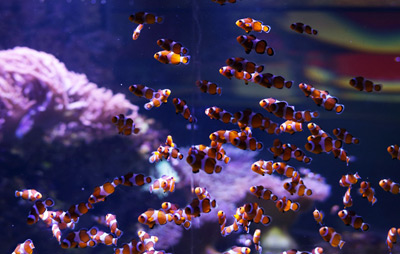It starts innocently enough. You’ve had a fish-only marine tank up and running for quite some time and would like to try your hand at reefkeeping—so one aquarium becomes two. Maybe then you realize that you need to rehome a fish that has outgrown its aquarium or is bullying its tankmates. You can’t bear to part with the specimen, so two tanks become three. Next, you catch the fish-breeding or coral-fragging bug and set up yet another system for that purpose—and three tanks become four. Before you know it, you can’t look at an empty container in your home without imagining what type of sea life it could hold!
This scenario represents the typical progression of an especially insidious disease known to afflict marine aquarium hobbyists—Multiple Saltwater Aquarium Syndrome, or MSAS.
Who is at risk?
The only known risk factor for MSAS is participation in the marine aquarium hobby, with the degree of risk being directly proportional to the duration of involvement. Regular submersion of the body in natural saltwater environments, e.g. scuba diving or snorkeling around coral reefs, may be a predisposing factor as well. Interestingly, spouses or partners of infected persons often exhibit a surprising level of immunity to the disease.
How does MSAS spread?
Dubious studies have revealed that MSAS is highly communicable and typically spread through direct exposure to the homes or fishrooms of already-infected hobbyists. Visits to particularly impressive public aquariums or even local fish stores can also spread the contagion to susceptible individuals. Family history—more precisely, having at least one first-degree relative (parent or sibling) with MSAS—may play a role as well.
Symptoms of MSAS
In its earliest stage, MSAS is easily overlooked and very difficult to distinguish from normal hobbyist behavior. However, left untreated, it can soon lead to a wide range of worrisome symptoms and comorbidities, including:
- A distinct briny smell permeating the sufferer’s household and clothing.
- Persistent pruning of the fingers.
- Steady, inexorable loss of living space as new tanks spring up in every corner, along every wall, and atop every level surface.
- Moving children from their bedrooms to a basement crawlspace to make room for more tanks, claiming “They’ll just be happier there!”
- Exhibiting evasive or deceptive behavior, e.g., communicating with other MSAS sufferers in Pig Latin (“Allyay Iyay eednay isyay oneyay oremay anktay!”), in an effort to conceal the severity of the disease from loved ones.
- Simmering domestic discord as limited financial resources are diverted from “non-essential” expenditures—cable TV, carry-out food, kids’ tuition, etc.—to “essential” expenditures, like fish food, protein skimmers, powerheads, heaters, lights…and more tanks.
- General malaise, disorientation, or irritability whenever the sufferer is removed from the multi-aquarium environment.
Can MSAS be treated?
There’s no known cure for MSAS and, thus far, no satisfactory treatment has been developed. MSAS immunotherapy—gradually exposing sufferers to incrementally increasing numbers of marine aquariums in an effort to desensitize them—backfired horribly, and aversion therapy had no discernible effect on MSAS sufferers apart from an inexplicable compulsion to watch Stanley Kubrick films. Some experts (on the courtship behavior of fruit flies) suggest MSAS may be a self-limiting disease that is best left to run its course.
Until more is understood about this sinister condition, hobbyists are advised to be on their guard in multiple-aquarium environments or even when talking to hobbyists infected with MSAS. But above all, they should keep repeating to themselves, “They’re just aquariums! They’re not love!”



